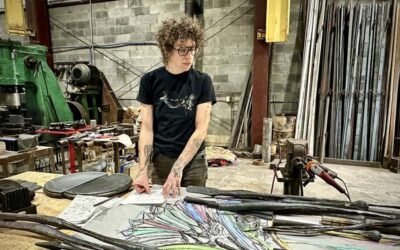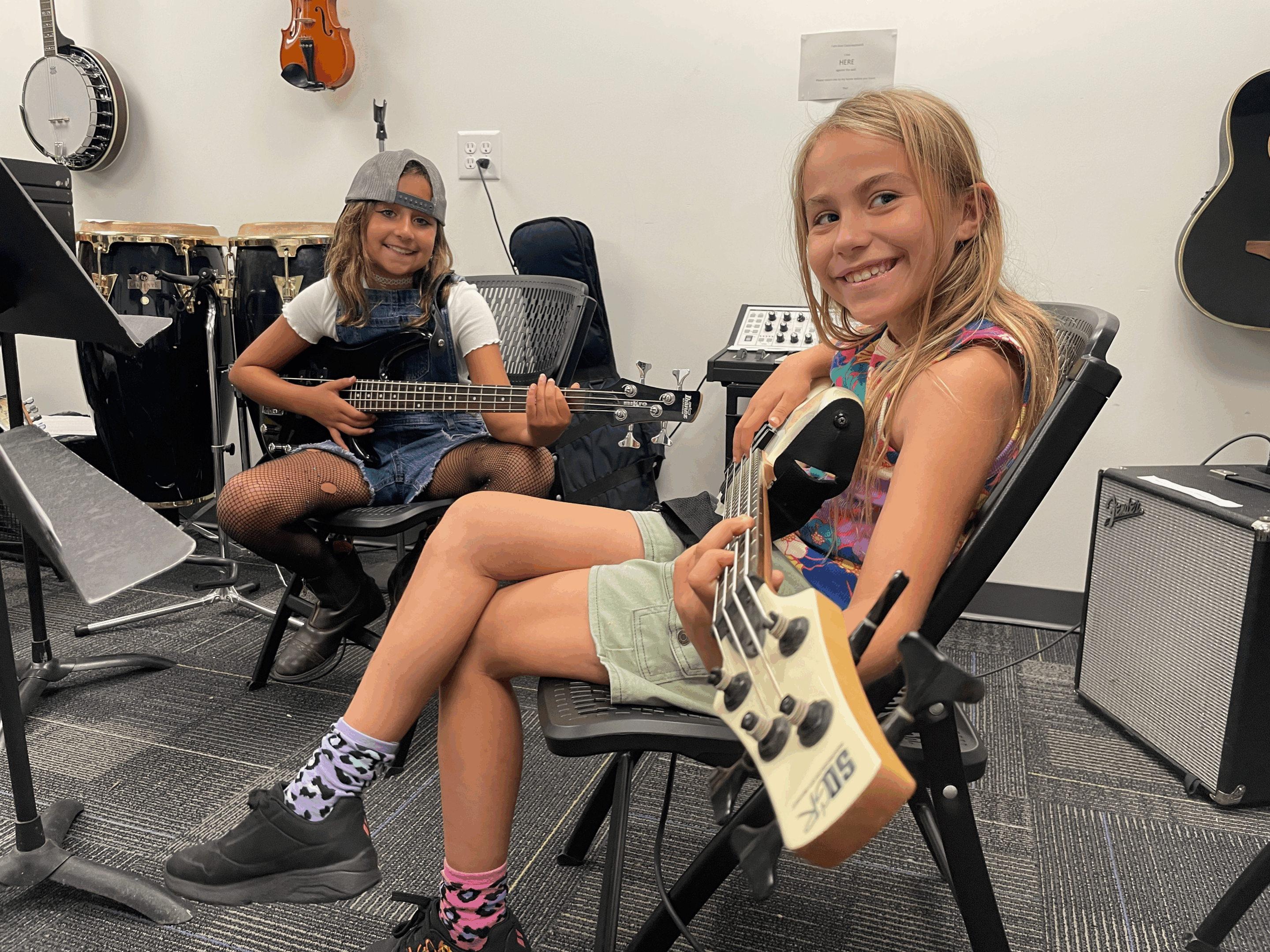
Rock Pyle rehearsal space, mural by Kathryn Crawford | Courtesy of RadHaus Studios
RadHaus Studios Brings Affordability and Aesthetics to Rehearsing and Recording
The founder of the new space envisions an incubator for area artists
April 30, 2024 | As part of our continuing series profiling pioneering creative spaces in Buncombe County, we are highlighting RadHaus Studios, a new visual and audio recording and rehearsal space located in East Asheville on the grounds of Highland Brewing Company (12 Old Charlotte Hwy., Ste. 10). RadHaus opened on March 30, 2024, offering affordable spaces for artists to rehearse and record with multiple customizable options.
The March opening was the culmination of a decade of work for Rebekkah Hilgraves, RadHaus’s owner. The decision to move what had been a mobile operation into a permanent brick and mortar location was serendipitous. The 4,600-square-foot space was “about twice as much as I originally planned getting into,” says Hilgraves, “but I started walking through and realized it had space for everything. It was perfect.”
Plenty of space – and plenty of options
RadHaus has two wings. The rehearsal wing has two 15 x 15 ft rooms (the aquatically-decorated “Sea Flat” (where you can “B natural,” says Hilgraves, laughing) and the psychedelia-themed “Rock Pyle,” named for musician Artemis Pyle, who rehearses there. That room also includes a mural painted by local artist Kathryn Crawford. Each fits up to a six-piece band and has its own unique acoustical treatment created from colorful, recycled polyester panels rather than the usual egg crate foam. An instructor in residence, Austin Barrett (The Sound Room AVL), also teaches out of the rehearsal wing.
Finding rehearsal space in Asheville is a challenge for artists, says Hilgraves, and it’s one that RadHaus hopes to make easier. Hilgraves is herself in a band, Pinkish Floyd, that now rehearses at RadHaus. “One of our biggest challenges was finding rehearsal space, because there are not enough rehearsal rooms in town – and certainly not large rooms that are affordable,” she says.
RadHaus’s rehearsal rooms cost $25 per hour. “I’m trying to keep public costs low, to basically cover my expenses and pay my crew members,” she says. “I want to make it easy.” Although they are priced on the low end for the area, Hilgraves emphasizes that they are clean, unique, and have “great amenities other spaces don’t have.”
The tracking/recording wing has two live tracking rooms. The 18 x 30 ft Spark Chamber, named in honor of former Asheville-based musician Sally Sparks, can fit large ensembles. Sparks’s 1989, 7 1/2 ft Yamaha concert grand piano adorns the space, and is “one of the finest instruments I’ve ever recorded,” Hilgraves says. The 15 x 18 ft Fireside room, named for a decal of a fireplace on the wall that was there when the team arrived, has drop ceilings that create an intimate feel for acoustic recordings. Each has its own control room.
A third tracking space is an isolation suite with separate rooms for instruments, including a whisper room for tracking vocals. A fourth room is a 15 x 23 ft video and photography studio, complete with a chroma green wall and custom backdrops, some created by local photographers.
The space also has a kitchen and breakroom and, Hilgraves stresses, “good bathrooms.” Clients can, of course, also take advantage of Highland’s proximity.
Besides being next door to Asheville’s oldest brewery, Hilgraves saw other pluses to the location. “It’s up on a hill and there is no city noise to contend with,” she says, noting that another part of town, like the River Arts District, would have required the team to “build a building within a building to be isolated.” People come and go at Highland, she notes, but it’s a safe, clean property.
The team – and vision – assembles
Although Hilgraves has worked in audio technology for four decades (primarily in the classical and jazz world), the dream of RadHaus was birthed during the pandemic, when she and her team started White Horse Live, a streaming series, from the then-shuttered White Horse Black Mountain. “We ran sound and multiple cameras, and had mixers for both live (front of house) sound and broadcast for the stream. I had never done video to this scale before, and I learned so much along the way.”
Beyond learning new skills, Hilgraves also brought together the team that would eventually open RadHaus. “I got lucky and assembled an amazing crew of women. Once the pandemic was over and White Horse’s doors were open again, we decided to do our own thing.” A solar-powered mobile rig she had built for the White Horse shows is available for offsite recording, and has been taken on the road to the Wortham Center for the Performing Arts and the Women to the Front Festival. It can run for eight hours on a bright day, powering up to 40 channels of audio and eight cameras with remote live switching capabilities.
RadHaus arrives on the scene with a collaborative spirit. Hilgraves says she is discussing how RadHaus and Highland (which owns the property) might partner in the future, including recording or streaming Meadow shows and special events. They have also had discussions with several other studios in town about partnership opportunities, and actively refer people to other studios when they are looking for something specific that might not be available at RadHaus. “There’s enough music happening in town to where we are all going to be busy,” says Hilgraves.
She sees a specific niche for people looking for an affordable option, as well as those who want to work with a majority-female team. “Women still make up less than 10% of the overall audio engineering industry,” she explains. “That number is slowly changing, and I’m hoping to encourage young women to get into audio tech.” She lauds UNC Asheville’s program and its internship-to-career pipeline, through which she has hired staff.
“I started choosing female engineers because we work together differently,” she explains. “Women are all very collaborative, and we’re all always learning from each other. There’s this collaborative camaraderie that we have built as a result of gender-based interpersonal challenges.” She points to past experiences battling the “boys’ club” mentality prevalent for years in the industry as motivating her decisions to hire mostly women.
“A one-stop shop for arts incubation”
In the future, Hilgraves wants to launch a training program for people who are underrepresented in the industry, including young women and people of color, “This is not just a studio where we’ll push a button and that’s it,” she says. “We want to collaborate with artists to help them craft their sound and find their unique voice.”
For now, Hilgraves still has a job outside of RadHaus, and she is working hard to raise the studio’s profile, which she notes happens mostly through referrals. “It’s a brand new studio, so we aren’t busy enough yet to be self-sufficient,” she explains. “But,” she stresses, “this space isn’t just for music or videos.” She encourages people to think more broadly, pointing to clients who have run multi-day webinars, product and fashion photo shoots, corporate events, and podcasting from the studio.
She is also in talks with theater and improv groups to do rehearsals and classes at the space. Ultimately, all of this is part of her larger vision for RadHaus. “We hope we can be a full-service, one-stop shop for arts incubation,” Hilgraves says.
Hear from Hilgraves, as well as other leaders behind our Creative Spaces, at the May 10 Town Hall, where ArtsAVL will also release the Creative Spaces Report, which will assess the local creative landscape and provide crucial information and address challenges and opportunities for the creative community. Visit artsavl.org/spaces to register and see project updates.
Related Articles
Whimsy and Wonder: Storybook Trolls and Reclaimed Wood Art Transform The North Carolina Arboretum
Whimsy and Wonder: Storybook Trolls and Reclaimed Wood Art Transform The North Carolina...
A New Chapter for the Asheville Urban Trail
Photo courtesy of Red Metal A New Chapter for the Asheville Urban Trail After more than two...
ArtsAVL Announces 2025–26 Grassroots Arts Grants for 49 Local Arts Nonprofits
Photo courtesy of Asheville Music School ArtsAVL Announces 2025–26 Grassroots Arts Grants for 49...



